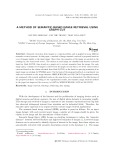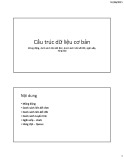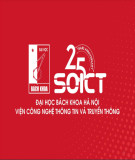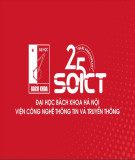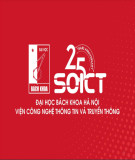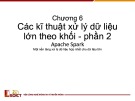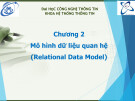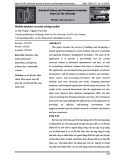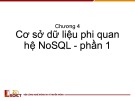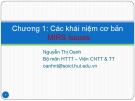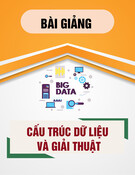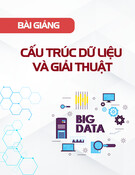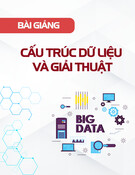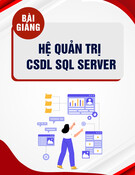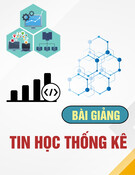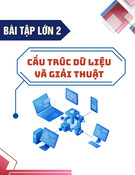Chapter 3 Data modelling and databases
1
Outline
• Data model
• Data modeling
• E/R model
• Ralational data model
• Data modeling process
2
Data model
• A collection of conceptual tools for describing data, data relationships, data semantics and consistency constraint.
• A conceptual representation of data structures
• Visually represents the nature of data, business rules governing the data, and how it will be organized in the database.
3
Data modeling
• Process of creating a data model for an information
system by applying certain formal techniques.
• Defining and analyze data requirements needed to
support the business processes.
• Involving professional data modelers working closely with business stakeholders, as well as potential users of the information system.
• Objectives
• To make sure all data objects required by a database are
completely and accurately represented
• The blueprint for creating a physical implementation of a
database (commonly)
4
Data modeling requirements
• What is the information/data domain that you are
modeling?
• What are the queries that you want to do?
• e.g., “Find out the most wanted products? How many sales
today?”
• What software do you want (have) to use?
• How do you want to share the data?
5
Data Model Terms
• Entity – a class of real world objects having common
attributes (e.g., sites, variables, methods).
• Attribute – A characteristic or property of an entity (site
name, latitude, longitude)
• Relationship – an association between two or more
entities
• Cardinality – the number of entities on either end of a relationship (one-to-one, one-to-many, many-to-many, etc.)
6
Examples
• Consider:
• What is the “entity”? • What are the “attributes” of the
entity?
7
Examples
• What is the entity?
• What are the attributes?
8
Examples
• What is the entity?
• What are the attributes?
9
Examples
• What are the relationships?
Grows In
Apple
Apple Tree
Orchard
Grows On
10
Different levels of data models
11
Different levels of data models
• Conceptual: describes WHAT the system contains
• High-level description of the data domain • Does not constrain how that description is mapped to an
actual implementation in software
• Logical: describes HOW the system will be
implemented, regardless of the DBMS
• Technology independent • Contains more detail than the Conceptual Data Model
• Physical: describes HOW the system will be
implemented using a specific DBMS
12
Conceptual data models
• WHAT the system contains.
13
Logical data models
• HOW the system will be implemented, regardless of
the DBMS
14
Physical data models
• HOW the system will be implemented using a specific
DBMS
15
Entity – Relationship model
16
E/R data model
• E/R is a visual syntax for DB design which is precise
enough for technical points, but abstracted enough for non-technical people
name
name
category
price
Product
Makes
Company
17
Entity and Entity sets
• Entity
• is a thing in the real world with an independent existence. • An entity may be an object with a physical existence (a
particular person, car, house, or employee) or it may be an object with a conceptual existence (a company, a job, or a university course).
• Entity sets
• a collection of similar entities forms an entity set.
• In ERD, rectangular boxes represent for entity sets
Attributes
• Entity sets have associated attributes, which are
properties of the entities in that set.
• For instance, each entity "student" has some properties such as student_id, first_name, last_name, dob, gender, address, and so on.
• In ERD, ovals represent for attributes
• Value domain of an attribute
• Each simple attribute of an entity type is associated with a
value set (or domain of values).
• For example: domain(gender) = {male, female}; domain(dob)
= {date}; domain(last_name) = {char(30)}.
student_id
student
gender
full_name
dob
Example: Entities, Entity sets, and attributes
Example:
Entities are not explicitly represented in E/R diagrams!
Entity
name
category
price
Product
Entity Attribute
Name: My Little Pony Doll Category: Toy Price: $25
Name: Xbox Category: Total Multimedia System Price: $250
Product
Entity Set
20
Attribute types
• Simple/atomic
city
state
street
note
attributes: Attributes that are not divisible. • Composite attributes:
address
student_id
student
gender
full_name
dob
attributes can be divided into smaller subparts, which represent more basic attributes with independent meanings.
first_name
last_name
Attribute types
lecturer
• Single-valued attributes: have a single value for a particular entity
subject_id
subject
• Multi-valued attributes: can have different numbers of values
credit
name
Attribute types
• Stored attributes vs.
dob
student_id
student
Derived attributes: age attribute is called a derived attribute and is said to be derivable from the dob attribute, which is called a stored attribute.
age
full_name
Keys
• A key is a minimal set of attributes that uniquely
identifies an entity.
• One or more attributes whose values are distinct for each
individual entity in the entity set
• Each entity can have some keys (candidate keys). We
choose one of them to be primary key.
• In ER diagrammatic notation, each key attribute has its
name underlined inside the oval.
student_id
student
gender
full_name
dob
Relationships
• Relationships are connections among two or more
entity sets.
• In ER diagrams, relationship types are displayed as
diamond-shaped boxes
• which are connected by straight lines to the rectangular boxes
representing the participating entity types.
• The relationship name is displayed in the diamond-shaped
box.
subject
learn
student
Relationship attributes
dob
subject_id
lecturer
student_id
subject
learn
student
credit
full_name
age
result
name
Relationship types
1
1
• 1 – 1
manage
manager
shop
• 1 – n
n
1
• n – m
join
student
class
• recursive
m
n
enroll
student
course
role1
condition
subject
role2
How to create an ERD
• Step 1: Identify all entity sets
• Notice concepts, nouns
• Step 2: Identify all relationships among entity sets
• Notice verbs • Type and degree of relationships
An example
• Read carefully the following scenario:
• The information about students includes student identification (uniquely identify each student), name, gender, date of birth and address.
• During the education time at school, students must study a lot
of subjects. A subject can be learnt by students. A subject should be contained information such as subject identification, name and credit.
• A lecturer can teach some subjects, and a subject can be
taught by a group of lecturers. The information about lecturers should include lecturer identification, name, phone, email. • Students learn subjects at some semester, and their results
should be stored.
An example
• We can draw this ER diagram
subject_id
lecturer_id
name
credit
result
student_id
dob
m
n
m
n
subject
lecturer
teach
student
learn
name
phone
gender
address
name
semester
What is a Relationship?
• A mathematical definition:
B=
• Let A, B be sets
A=
1
a
b
2
• A x B (the cross-product) is the set of all pairs
(a,b)
c
3
• A={1,2,3}, B={a,b,c,d},
d
• We define a relationship to be a subset of A
• A ´B = {(1,a), (1,b), (1,c), (1,d), (2,a), (2,b), (2,c), (2,d), (3,a), (3,b), (3,c), (3,d)}
x B
31
• R = {(1,a), (2,c), (2,d), (3,b)}
What is a Relationship?
name
name
category
price
Product
Makes
Company
A relationship between entity sets P and C is a subset of all possible pairs of entities in P and C, with tuples uniquely identified by P and C’s keys
32
What is a Relationship?
Product name
category
price
Company name
Gizmo
Electronics
$9.99
GizmoWorks
GizmoLite Electronics
$7.50
GadgetCorp
Gadget
Toys
$5.50
name
name
category
price
Product
Makes
Company
A relationship between entity sets P and C is a subset of all possible pairs of entities in P and C, with tuples uniquely identified by P and C’s keys
33
What is a Relationship?
Company C × Product P
C.name
P.name
P.category
P.price
Product name
category
price
Company name
GizmoWorks Gizmo
Electronics
$9.99
Gizmo
Electronics
$9.99
GizmoWorks
GizmoWorks GizmoLite
Electronics
$7.50
GizmoLite Electronics
$7.50
GadgetCorp
GizmoWorks Gadget
Toys
$5.50
Gadget
Toys
$5.50
GadgetCorp
Gizmo
Electronics
$9.99
GadgetCorp
GizmoLite
Electronics
$7.50
GadgetCorp
Gadget
Toys
$5.50
name
name
category
price
Product
Makes
Company
A relationship between entity sets P and C is a subset of all possible pairs of entities in P and C, with tuples uniquely identified by P and C’s keys
34
What is a Relationship?
Company C × Product P
C.name
P.name
P.category
P.price
Product name
category
price
Company name
GizmoWorks Gizmo
Electronics
$9.99
Gizmo
Electronics
$9.99
GizmoWorks
GizmoWorks GizmoLite
Electronics
$7.50
GizmoLite Electronics
$7.50
GadgetCorp
GizmoWorks Gadget
Toys
$5.50
Gadget
Toys
$5.50
GadgetCorp
Gizmo
Electronics
$9.99
GadgetCorp
GizmoLite
Electronics
$7.50
GadgetCorp
Gadget
Toys
$5.50
name
name
category
price
Product
Makes
Company
Makes
C.name
P.name
GizmoWorks Gizmo
GizmoWorks GizmoLite
GadgetCorp
Gadget
A relationship between entity sets P and C is a subset of all possible pairs of entities in P and C, with tuples uniquely identified by P and C’s keys
35
What is a Relationship?
• There can only be one relationship for every unique combination of entities
This follows from our mathematical definition of a relationship- it’s a SET!
• This also means that the relationship is uniquely determined by the keys of its entities
KeyMakes = KeyProduct ∪ KeyCompany
since
name
name
category
• Example: the “key” for Makes (to right) is
price
{Product.name, Company.name}
Product
Makes
Company
36
Decision: Relationship vs. Entity?
• Q: What does this say?
date
name
name
category
price
Product
Purchased
Person
• A: A person can only buy a specific product once (on one
date)
Modeling something as a relationship makes it unique; what if not appropriate?
37
Decision: Relationship vs. Entity?
• What about this way?
date
PID#
quantity
name
name
category
Purchase
price
ProductOf
BuyerOf
Product
Person
• Now we can have multiple purchases per product, person pair!
We can always use a new entity instead of a relationship. For example, to permit multiple instances of each entity combination!
38
Relational data model
39
Relational Data Model
• introduced by C F Codd in 1970 • A logical view of data • Enables programmer to view data logically rather than
physically
• Simple and uniform data model • Based on a firm mathematical foundation (set theory) • Main aspects:
• Data structure: n-ary two dimensional
Student
• Attributes, domain value • Tuples • Tables/relations
Id Name Suburb
1108 Robert Kew
3936 Glen Bundoora
• Integrity constraints • entity integrity • referential integrity
8507 Norman Bundoora
40
8452 Mary Balwyn
Example: University Database
Takes SID
SNO
Enrol
1108 21
Student Id
Name Suburb SID Course
1108 23 1108 Robert Kew 3936 101
1108 29 3936 Glen Bundoora 1108 113
8507 23 8507 Norman Bundoora 8507 101
8507 29 8452 Mary Balwyn
Subject
Course
No Name Dept
No Name Dept 21 Systems CSCE
113 BCS CSCE 23 Database CSCE
101 MCS CSCE 29 VB CSCE
41
18 Algebra Maths
Attribute
• Definition
• designated by a meaningful name • also called field or column • denoted A ü Example
• Id, name, suburb, dept, …
• Domain
• define the original sets of data values used • denoted Domain(A) Ö Example
• text, number, boolean, date/time, memo • Id: text(10) • Name: text(30) • birthday: date • …
42
Relation
• Definition
• Defined as a set of attribute • also called table • Denoted R(A1,A2, … An)
R(A1,A2, … An) Í Dom(A1) x … x Dom(An)
ü Example
, Name, Suburb)
• STUDENT(Id • SUBJECT (No, Name, Dept)
• A relation is composed of tuples
43
Tuple
• Definition
• defined as a set of attribute value • also called record or row • Denoted t(a1,a2, … an) • t(a1,a2, … an) Î Dom(A1) x … x Dom(An) ü Example
(1108, Robert, Kew)
(3936, Glen, Bundoora)
• Each tuple must have a primary key which can
uniquely identified the tuple.
44
Key
• Definition
• A set of attribute in a relation • Used to identify each tuple • Given R(A1,A2, … An), K Í {Ai},
K is key if "t1, t2 ÎR, $Ai ÎK: t1.K¹t2.K
ü Example
, Name, Suburb)
• STUDENT(Id • TAKE(SID, SNO)
• Remark:
•
If
à
K Í {Ai} is key and K Í K’ Í {Ai} K’ is super key
• candidate key
• a superkey without redundant attributes
45
Primary key
• Definition
• a “smallest” key, i.e. with single attribute or smallest number
of attributes allowing identify a unique tuple
• A candidate key chosen to be the main key for the relation
• Entity constraint:
• No attribute in the primary key can be NULL
ü Example
, Name, Suburb)
• STUDENT(Id • SUBJECT (No, Name, Dept)
46
Foreign key
• Specified between two relations and maintain the correspondence between tuples in these relations
• also called referential integrity
• A set of attributes FK in a relation R1 is foreign key if
• The attributes in FK correspond to the attributes in the primary
key of another relation R2
• The value for FK in each tuple of R1 either occur as values of
primary key of a tuple in R2 or is entirely NULL
47
Example: University Database
Takes SID
SNO
Enrol
1108 21
Student Id
Name Suburb SID Course
1108 23 1108 Robert Kew 3936 101
1108 29 3936 Glen Bundoora 1108 113
8507 23 8507 Norman Bundoora 8507 101
8507 29 8452 Mary Balwyn
Subject
Course
No Name Dept
No Name Dept 21 Systems CSCE
113 BCS CSCE 23 Database CSCE
101 MCS CSCE 29 VB CSCE
48
18 Algebra Maths
Takes SID
SNO
1108 21
Student Id
Name Suburb
1108 23 1108 Robert Kew
1108 29 3936 Glen Bundoora
8507 23 8507 Norman Bundoora
8507 29 8452 Mary Balwyn
Enrol
Subject
No Name Dept SID Course
3936 101 21 Systems CSCE
1108 113 23 Database CSCE
8507 101 29 VB CSCE
49
18 Algebra Maths
A Brief History
Relationa l model
Extended Relational Model
Hierarchical model
DB2, ORACLE- 10i, SQL Server ...
XML
1970
1975 1980
1985
1990 1995 2000
2005 2010
System R(81), DB2, ORACLE, SQL Server, Sybase, ...
Entity-Relationship Model
IMS, System 2k, ... 1965
Network model
Semi-structure Model
IRDS(87) ,CDD+, ... Object-Oriented model
O2, ORION, IRIS, ...
50
Lore (97), ...
DMS(65), CODASYL (71), IDMS, IDS
Building Models Top Down vs. Bottom Up
• Top-Down
• Bottom-Up
• Using a Hybrid Approach – Middle Out
51
Top-down
© CHRISTOPHER BRADLEY (CDMP FELLOW) 52
Bottom-up
© CHRISTOPHER BRADLEY (CDMP FELLOW) 53
Conclusion
• In this lesson you have learnt
• Data model • Data modeling • E/R model • Ralational data model • Data modeling process
54
Thank you for your attention!!!
55
© CHRISTOPHER BRADLEY (CDMP FELLOW) 56

